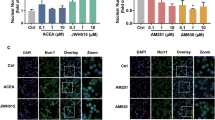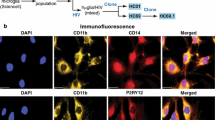Abstract
Microglia are a population of macrophage-like cells in the central nervous system (CNS) which, upon infection by the human immunodeficiency virus (HIV), secrete a plethora of inflammatory factors, including the virus-specified trans-activating protein Tat. Tat has been implicated in HIV neuropathogenesis since it elicits chemokines, cytokines, and a chemotactic response from microglia. It also harbors a β-chemokine receptor binding motif, articulating a mode by which it acts as a migration stimulus. Since select cannabinoids have anti-inflammatory properties, cross the blood–brain barrier, and target specific receptors, they have potential to serve as agents for dampening untoward neuroimmune responses. The aim of this study was to investigate the effect of select cannabinoids on the migration of microglial-like cells toward Tat. Using a mouse BV-2 microglial-like cell model, it was demonstrated that the exogenous cannabinoids Delta-9-tetrahydrocannabinol (THC) and CP55940 exerted a concentration-related reduction in the migration of BV-2 cells towards Tat. A similar inhibitory response was obtained when the endogenous cannabinoid 2-arachidonoylglycerol (2-AG) was used. The CB2 receptor (CB2R) antagonist SR144528, but not the CB1 receptor (CB1R) antagonist SR141716A, blocked this inhibition of migration. Similarly, CB2R knockdown with small interfering RNA reversed the cannabinoid-mediated inhibition. In addition, the level of the β-chemokine receptor CCR-3 was reduced and its intracellular compartmentation was altered. These results indicate that cannabinoid-mediated inhibition of BV-2 microglial-like cell migration to Tat is linked functionally to the CB2R. Furthermore, the results indicate that activation of the CB2R leads to altered expression and compartmentation of the β-chemokine receptor CCR-3.







Similar content being viewed by others
References
Albini A, Mitchell CD, Thompson EW, Seeman R, Martin GR, Wittek AE, Quinnan GV (1988) Invasive activity and chemotactic response to growth factors by Kaposi’s sarcoma cells. J Cell Biochem 36:369–376
Albini A, Benelli R, Giunciuglio D, Cai T, Mariani G, Ferrini S, Noonan DM (1998) Identification of a novel domain of HIV tat involved in monocyte chemotaxis. J Biol Chem 273:15895–15900
Banks WA, Robinson SM, Nath A (2005) Permeability of the blood-brain barrier to HIV-1 Tat. Exp Neurol 193:218–227
Benelli R, Mortarini R, Anichini A, Giunciuglio D, Noonan DM, Montalti S, Tacchetti C, Albini A (1998) Monocyte-derived dendritic cells and monocytes migrate to HIV-Tat RGD and basic peptides. AIDS 12:261–268
Benito C, Kim WK, Chavarria I, Hillard CJ, Mackie K, Tolon RM, Williams K, Romero J (2005) A glial endogenous cannabinoid system is upregulated in the brains of macaques with simian immunodeficiency virus-induced encephalitis. J Neurosci 25:2530–2536
Benveniste EN (1998) Cytokine actions in the central nervous system. Cytokine Growth Factor Rev 9:259–275
Berman NE, Marcario JK, Yong C, Raghavan R, Raymond LA, Joag SV, Narayan O, Cheney PD (1999) Microglial activation and neurological symptoms in the SIV model of NeuroAIDS: association of MHC-II and MMP-9 expression with behavioral deficits and evoked potential changes. Neurobiol Dis 6:486–498
Blasi E, Barluzzi R, Bocchini V, Mazzolla R, Bistoni F (1990) Immortalization of murine microglial cells by a v-raf/v-myc carrying retrovirus. J Neuroimmunol 27:229–237
Bradford MM (1976) A rapid and sensitive method for the quantitation of microgram quantities of protein utilizing the principle of protein-dye binding. Anal Biochem 72:248–254
Buttini M, Appel K, Sauter A, Gebicke-Haerter PJ, Boddeke HW (1996) Expression of tumor necrosis factor alpha after focal cerebral ischaemia in the rat. Neuroscience 71:1–16
Cabral GA, Marciano-Cabral F (2005) Cannabinoid receptors in microglia of the central nervous system: immune functional relevance. J Leukocyte Biol 78:1192–1197
Cabral GA, Staab A (2005) Effects on the immune system. Handb Exp Pharmacol 168:385–423
Chang HK, Gallo RC, Ensoli B (1995) Regulation of cellular gene expression and function by the human immunodeficiency virus type 1 Tat protein. J Biomed Sci 2:189–202
Chung H, Brazil MI, Soe TT, Maxfield FR (1999) Uptake, degradation, and release of fibrillar and soluble forms of Alzheimer’s amyloid beta-peptide by microglial cells. J Biol Chem 274:32301–32308
D’Aversa TG, Yu KO, Berman JW (2004) Expression of chemokines by human fetal microglia after treatment with the human immunodeficiency virus type 1 protein Tat. J Neurovirol 10:86–97
de Paulis A, De Palma R, Di Gioia L, Carfora M, Prevete N, Tosi G, Accolla RS, Marone G (2000) Tat protein is an HIV-1-encoded beta-chemokine homolog that promotes migration and up-regulates CCR3 expression on human Fc epsilon RI + cells. J Immunol 165:7171–7179
Ehrhart J, Obregon D, Mori T, Hou H, Sun N, Bai Y, Klein T, Fernandez F, Tan J, Shytle RD (2005) Stimulation of cannabinoid receptor 2 (CB2) suppresses microglial activation. J Neuroinflammation 2:29
Ensoli B, Buonaguro L, Barillari G, Fiorelli V, Gendelman R, Morgan RA, Wingfield P, Gallo RC (1993) Release, uptake, and effects of extracellular human immunodeficiency virus type 1 Tat protein on cell growth and viral transactivation. J Virol 67:277–287
Gehrmann J (1996) Microglia: a sensor to threats in the nervous system? Res Virol 147:79–88
Gendelman HE, Persidsky Y, Ghorpade A, Limoges J, Stins M, Fiala M, Morrisett R (1997) The neuropathogenesis of the AIDS dementia complex. AIDS 11(Suppl A):S35–S45
Giulian D, Baker TJ, Shih LC, Lachman LB (1986) Interleukin 1 of the central nervous system is produced by ameboid microglia. J Exp Med 164:594–604
Henn A, Lund S, Hedtjarn M, Schrattenholz A, Porzgen P, Leist M (2009) The suitability of BV2 cells as alternative model system for primary microglia cultures or for animal experiments examining brain inflammation. ALTEX 26:83–94
Horvath RJ, Nutile-McMenemy N, Alkaitis MS, DeLeo JA (2008) Differential migration, LPS-induced cytokine, chemokine, and NO expression in immortalized BV-2 and HAPI cell lines and primary microglial cultures. J Neurochem 107:557–569
Kremlev SG, Roberts RL, Palmer C (2004) Differential expression of chemokines and chemokine receptors during microglial activation and inhibition. J Neuroimmunol 149:1–9
Kreutzberg GW (1996) Microglia: a sensor for pathological events in the CNS. Trends Neurosci 19:312–318
Leong SK, Ling EA (1992) Amoeboid and ramified microglia: their interrelationship and response to brain injury. Glia 6:39–47
Liu J, Louie S, Hsu W, Yu KM, Nicholas HB Jr, Rosenquist GL (2008) Tyrosine sulfation is prevalent in human chemokine receptors important in lung disease. Am J Respir Cell Mol Biol 38:738–743
Marchalant Y, Brothers HM, Norman GJ, Karelina K, DeVries AC, Wenk GL (2009) Cannabinoids attenuate the effects of aging upon neuroinflammation and neurogenesis. Neurobiol Dis 34:300–307
Murikinati S, Juttler E, Keinert T, Ridder DA, Muhammad S, Waibler Z, Ledent C, Zimmer A, Kalinke U, Schwaninger M (2010) Activation of cannabinoid 2 receptors protects against cerebral ischemia by inhibiting neutrophil recruitment. FASEB J 24:788–798
Nath A, Conant K, Chen P, Scott C, Major EO (1999) Transient exposure to HIV-1 Tat protein results in cytokine production in macrophages and astrocytes. A hit and run phenomenon. J Biol Chem 274:17098–17102
Neel N, Schutyser E, Sai J, Fan GH, Richmond A (2005) Chemokine receptor internalization and intracellular trafficking. Cytokine Growth Factor Rev 16:637–658
New DR, Maggirwar SB, Epstein LG, Dewhurst S, Gelbard HA (1998) HIV-1 Tat induces neuronal death via tumor necrosis factor-alpha and activation of non-N-methyl-D-aspartate receptors by a NFkappaB-independent mechanism. J Biol Chem 273:17852–17858
Nowell KW, Pettit DA, Cabral WA, Zimmerman HW Jr, Abood ME, Cabral GA (1998) High-level expression of the human CB2 cannabinoid receptor using a baculovirus system. Biochem Pharmacol 55:1893–1905
Orsini MJ, Debouck CM, Webb CL, Lysko PG (1996) Extracellular human immunodeficiency virus type 1 Tat protein promotes aggregation and adhesion of cerebellar neurons. J Neurosci 16:2546–2552
Pearson VL, Rothwell NJ, Toulmond S (1999) Excitotoxic brain damage in the rat induces interleukin-1beta protein in microglia and astrocytes: correlation with the progression of cell death. Glia 25:311–323
Pietr M, Kozela E, Levy R, Rimmerman N, Lin YH, Stella N, Vogel Z, Juknat A (2009) Differential changes in GPR55 during microglial cell activation. FEBS Lett 583:2071–2076
Pu H, Tian J, Flora G, Lee YW, Nath A, Hennig B, Toborek M (2003) HIV-1 Tat protein upregulates inflammatory mediators and induces monocyte invasion into the brain. Mol Cell Neurosci 24:224–237
Raborn ES, Cabral GA (2010) Cannabinoid inhibition of macrophage migration to the trans-activating (Tat) protein of HIV-1 is linked to the CB(2) cannabinoid receptor. J Pharmacol Exp Ther 333:319–327
Re MC, Vignoli M, Furlini G, Gibellini D, Colangeli V, Vitone F, La Placa M (2001) Antibodies against full-length Tat protein and some low-molecular-weight Tat-peptides correlate with low or undetectable viral load in HIV-1 seropositive patients. J Clin Virol 21:81–89
Romero-Sandoval EA, Horvath R, Landry RP, DeLeo JA (2009) Cannabinoid receptor type 2 activation induces a microglial anti-inflammatory phenotype and reduces migration via MKP induction and ERK dephosphorylation. Mol Pain 5:25
Rostasy KM (2005) Inflammation and neuroaxonal injury in multiple sclerosis and AIDS dementia complex: implications for neuroprotective treatment. Neuropediatrics 36:230–239
Rotshenker S (2003) Microglia and macrophage activation and the regulation of complement-receptor-3 (CR3/MAC-1)-mediated myelin phagocytosis in injury and disease. J Mol Neurosci 21:65–72
Vene R, Benelli R, Noonan DM, Albini A (2000) HIV-Tat dependent chemotaxis and invasion, key aspects of tat mediated pathogenesis. Clin Exp Metastasis 18:533–538
Vila M, Jackson-Lewis V, Guegan C, Wu DC, Teismann P, Choi DK, Tieu K, Przedborski S (2001) The role of glial cells in Parkinson’s disease. Curr Opin Neurol 14:483–489
Wallace VC, Blackbeard J, Segerdahl AR, Hasnie F, Pheby T, McMahon SB, Rice AS (2007) Characterization of rodent models of HIV-gp120 and anti-retroviral-associated neuropathic pain. Brain 130:2688–2702
Walter L, Franklin A, Witting A, Wade C, Xie Y, Kunos G, Mackie K, Stella N (2003) Nonpsychotropic cannabinoid receptors regulate microglial cell migration. J Neurosci 23:1398–1405
Watson K, Edwards RJ (1999) HIV-1-trans-activating (Tat) protein: both a target and a tool in therapeutic approaches. Biochem Pharmacol 58:1521–1528
Zheng H, Loh HH, Law P-Y (2010) Agonist-selective signaling of G protein-coupled receptor: mechanisms and implications. IUBMB Life 62:112–119
Zimmermann N, Conkright J, Rothenberg M (1999) CC chemokine receptor-3 undergoes prolonged ligand-induced internalization. J Biol Chem 274:12611–12618
Acknowledgements
The deletion mutant Tat1-72 (TatΔ31–61) was provided by Dr. Avindra Nath through support provided by NIDA/NIH PO1 DA19398 and NIH (COBRE) P20 RR015592. The authors thank Ms. Melissa Jamerson for technical assistance with the confocal microscopy.
Conflict of interest
The authors have no conflict of interest.
Author information
Authors and Affiliations
Corresponding author
Additional information
Sources of support
This study was supported, in part, by NIDA/NIH awards DA005832 and DA029532.
Authors Daniel Fraga and Erinn S. Raborn contributed equally to this work.
Rights and permissions
About this article
Cite this article
Fraga, D., Raborn, E.S., Ferreira, G.A. et al. Cannabinoids Inhibit Migration of Microglial-like Cells to the HIV Protein Tat. J Neuroimmune Pharmacol 6, 566–577 (2011). https://doi.org/10.1007/s11481-011-9291-6
Received:
Accepted:
Published:
Issue Date:
DOI: https://doi.org/10.1007/s11481-011-9291-6




